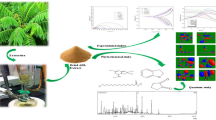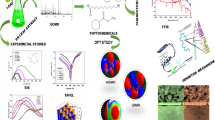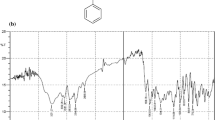Abstract
This study investigated the effect of Allium sativum extract on mild steel to show corrosion behavior in acidic medium (1 M HCl) by weight loss and SEM analysis. This test was performed on various temperatures viz 298 K, 313 K and 323 K for determination of corrosion rate. There was increasing inhibition efficiency with increasing concentration of inhibitor. The best inhibition efficiency (76.47%) was achieved at 298 K in the presence of 4 g/L of extract. These finding is also supported by the resistance of mild steel to corrosion in this medium decreased with the increase in austenitic temperature, which is observed from corrosion rate of 31.62 mmpy. Test results obeyed the Langmuir adsorption isotherm with a correlation coefficient (R2) of 0.999. Quantum chemical parameters calculated by Density functional theory (DFT) were correlated with the experimental results.







Similar content being viewed by others
References
Bhawsar J (2018) Eco friendly corrosion inhibitors: a review. Int J Res BioSci 7:100–105
Verma C, Ebenso EE, Bahadur I, Quraishi MA (2018) An overview on plant extracts as environmental sustainable and green corrosion inhibitors for metals and alloys in aggressive corrosive media. J Mol Liq 266:577–590
Popoola LT (2019) Progress on pharmaceutical drugs, plant extracts and ionic liquids as corrosion inhibitors. Heliyon 5:e0114
Mo S, Luo HQ, Li NB (2016) Plant extracts as “green” corrosion inhibitors for steel in sulphuric acid. Chem Pap 70:1131–1143
Fraunhofer JA (1995) Tobacco extract composition and methods, U.S. Patent, 43941
Lotto CA, Josheph OO, Lotto RT (2014) Adsorption and Inhibitive Properties of Camellia sinensis for aluminium alloy in HCI. Int J Electrochem Sci 9:3637–3649
Yetri Y, Gunawarman, Hidayati R, Zamri A (2019) Mechanical properties of mild steel by adding Theobroma cacao peels extract (TCPE) inhibitor. IOP Conference Series: Materials Science Engineering, vol 602, p 012088
Nathiya RS, Perumal S, Murugesan V, Raja V (2019) Evaluation of extracts of Borassus flabellifer dust as green inhibitors for aluminium corrosion in acidic media. Mater Sci Semicond Process 104:104674
Wang X, Jiang H, Zhang D, Hou L, Zhou W (2019) Solanum lasiocarpum L. extract as green corrosion inhibitor for A3 steel in 1 M HCl solution. Int J Electrochem Sci 14:1178–1196
Verma DK, Khan F, Bahadur I, Salman M, Quraishi MA, Verma C, Eno EE (2018) Inhibition performance of Glycine max, Cuscuta reflexa and Spirogyra extracts for mild steel dissolution in acidic medium: density functional theory and experimental studies. Results Phys 10:665–674
Zheng X, Gong M, Li Q et al (2018) Corrosion inhibition of mild steel in sulfuric acid solution by loquat (Eriobotrya japonica Lindl.) leaves extract. Sci Rep 8:9140
Arora P, Kumar S, Sharma MK, Mathur SP (2007) Corrosion inhibition of aluminium by Capparis deciduas in acidic media. J Chem 4:450–456
Al-Sehaibani H (2000) Evaluation of extracts of henna leaves as environmentally friendly corrosion inhibitors for metals. Mater Wiss Werkstofftech 31:1060–1063
Oguzie EE (2006) Inhibitory action of Phyllanthus amarus extracts on the corrosion of mild steel in acidic media. Mater Chem Phys 99:441–447
Abiola OK, Oforka NC, Ebenso EE (2006) The inhibition of mild steel corrosion in an acidic medium by fruit juice of citrus paradise. J Corros Sci Eng 5:1–7
Bhawsar J, Jain PK, Jain P, Soni A (2013) Anticorrosive activity of Glycine max (L) oil against the corrosion of mild steel in acidic medium. Int J Res Chem Environ 3:68–74
Bhawsar J, Jain P, Valladares-Cisneros MG, Cuevas-Arteaga C, Bhawsar MR (2018) Quantum chemical assessment of two natural compounds: Vasicine and Vasicinone as green corrosion inhibitors. Int J Electrochem Sci 13:3200–3209
Ojha LK, Kaur K, Kaur R, Bhawsar J (2017) Corrosion inhibition efficiency of fenugreek leaves extract on mild steel surface in acidic medium. J Chem Pharm Res 9:57–64
Augusti KT (1996) Therapeutic values of onion (Allium cepa L.) and garlic (Allium sativum L.). Indian J Exp Biol 3:634–640
Omar SH, Al-Wabel NA (2010) Organosulfur compounds and possible mechanism of garlic in cancer. Saudi Pharm J 18:51–58
Dennington R, Keith T, Millam J (2016) Gauss view, version 6. Semichem Inc., Shawnee Mission, KS
Frisch MJ, Trucks GW, Schlegel H, Scuseria GE, Robb MA, Cheeseman JR, Scalmani G, Barone V, Mennucci B, Petersson GA, Nakatsuji H, Caricato M, Li X, Hratchian HP, Izmaylov AF, Bloino J, Zheng G, Sonnenberg JL, Hada M, Ehara M, Toyota K, Fukuda R, Hasegawa J, Ishida M, Nakajima T, Honda Y, Kitao O, Nakai H, Vreven T, Montgomery JA Jr, Peralta JE, Ogliaro F, Bearpark M, Heyd JJ, Brothers E, Kudin KN, Staroverov VN, Kobayashi R, Normand J, Raghavachari K, Rendell A, Burant JC, Iyengar SS, Tomasi J, Cossi M, Rega N, Millam JM, Klene M, Knox JE, Cross JB, Bakken V, Adamo C, Jaramillo J, Gomperts R, Stratmann RE, Yazyev O, Austin AJ, Cammi R, Pomelli C, Ochterski JW, Martin RL, Morokuma K, Zakrzewski VG, Voth GA, Salvador P, Dannenberg JJ, Dapprich S, Daniels AD, Farkas O, Foresman JB, Ortiz JV, Cioslowski J, Fox DJ (2009) Gaussian 09, Revision D.01. Gaussian Inc., Wallingford, CT
Perkin Elmer, ChemBioDraw Ultra Version (13.0.0.3015), CambridgeSoft Waltham, MA (2012)
Chemissan Version 4.43 package (2016)
Wiberg KB (2004) Basis set effects on calculated geometries. J Comput Chem 25(11):1342–1346
Becke AD (1993) Density functional thermochemistry. III. The role of exact exchange. J Chem Phys 98(7):5648–5652
Hohenstein EG, Chill ST, Sherrill CD (2008) Assessment of the performance of the M05–2X and M06–2X exchange-correlation functionals for noncovalent interactions in biomolecules. J Chem Theor Comput 4:1996–2000
Kaya S, Tüzün B (2017) Conceptual density functional theoretical investigation of the corrosion inhibition efficiencies of some molecules containing mercapto (-SH) group. Curr Phys Chem 7:147–153
Kaya S, Tüzün B, Kaya C, Obot IB (2016) Determination of corrosion inhibition effects of amino acids: quantum chemical and molecular dynamic simulation study. J Taiwan Inst Chem Eng 58:528–553
Kaya S, Guo L, Kaya C, Tüzün B, Obot IB, Touir R, Islam N (2016) Quantum chemical and molecular dynamic simulation studies for the prediction of inhibition efficiencies of some piperidine derivatives on the corrosion of iron. J Taiwan Inst Chem Eng 65:522–529
Kaya S, Kaya C, Guo L, Kandemirli F, Tüzün B, Uğurlu I, Madkour LH, Saraçoğlu M (2016) Quantum chemical and molecular dynamics simulation studies on inhibition performances of some thiazole and thiadiazole derivatives against corrosion of iron. J Mol Liq 219:497–504
Obot IB, Kaya S, Kaya C, Tüzün B (2016) Density functional theory (DFT) modeling and Monte Carlo simulation assessment of inhibition performance of some carbohydrazide Schiff bases for steel corrosion. Physica E 80:82–90
Kaya S, Banerjee P, Saha SK, Tüzün B, Kaya C (2016) Theoretical evaluation of some benzotriazole and phospono derivatives as aluminum corrosion inhibitors: DFT and molecular dynamics simulation approaches. RSC Adv 6:74550–74559
Obot IB, Kaya S, Kaya C, Tüzün B (2016) Theoretical evaluation of triazine derivatives as steel corrosion inhibitors: DFT and Monte Carlo simulation approaches. Res Chem Intermed 42:4963–4983
Guo L, Safi Z, Kaya S, Shi W, Tüzün B, Altunay N, Kaya C (2018) Anticorrosive effects of some thiophene derivatives against the corrosion of iron: a computational study. Front Chem 6:155
Hepokur C, Günsel A, Yarasir MN, Bilgiçli AT, Tüzün B, Tüzün G, Yaylim I (2017) Novel type ketone-substituted metallophthalocyanines: synthesis, spectral, structural, computational and anticancer studies. RSC Adv 89:56296–56305
Brus LE (1983) A simple model for the ionization potential, electron affinity, and aqueous redox potentials of small semiconductor crystallites. J Chem Phys 79:5566–5571
Parr RG, Yang W (1989) Density functional theory of atoms and molecules. Oxford University Press, Oxford
Singh A, Ebenso EE, Quraishi MA (2012) Theoretical and electrochemical studies of Cuminum cyminum (Jeera) extract as green corrosion inhibitor for mild steel in hydrochloric acid solution. Int J Electrochem Sci 7:8543–8559
Bhawsar J, Jain PK, Jain P (2015) Experimental and computational studies of Nicotiana tabacum leaves extract as green corrosion inhibitor for mild steel in acidic medium. Alex Eng J 54(3):769–775
Kose E, Atac A, Bardak F (2018) The structural and spectroscopic investigation of 2-chloro-3-methylquinoline by DFT method and UV–Vis, NMR and vibrational spectral techniques combined with molecular docking analysis. J Mol Struct 1163:147–160
Zhang Z, Li W, Zhang W, Huang X, Ruan L, Wu L (2018) Experimental, quantum chemical calculations and molecular dynamics (MD) simulation studies of methionine and valine as corrosion inhibitors on carbon steel in phase change materials (PCMs) solution. J Mol Liq 272:528–538
Nabah R, Benhiba F, Ramli Y, Ouakki M, Cherkaoui M, Oudda H, Zarrouk A (2018) Corrosion inhibition study of 5,5-diphenylimidazolidine-2,4-dione for mild steel corrosion in 1 M HCl solution: experimental, theoretical computational and Monte Carlo simulations studies. Anal Bioanal Electrochem 10:1375–1398
Uludağ N, Serdaroğlu G (2019) A DFT investigation on the structure, spectroscopy (FTIR and NMR), donor-acceptor interactions and non-linear optic properties of (±)1,2-dehydroaspidospermidine. Chem Sel 4:6870–6878
Tüzün B, Sayin K (2019) Investigations over optical properties of boron complexes of benzothiazolines. Spectrochim Acta A 208:48–56
Lukovits I, Kálmán E, Zucchi F (2001) Corrosion inhibitors—correlation between electronic structure and efficiency. Corrosion 57(1):3–8
Akhtar M, Khajuria A, Sahu JK et al (2018) Phase transformations and numerical modelling in simulated HAZ of nanostructured P91B steel for high temperature applications. Appl Nanosci 8:1669
Khajuria A, Kumar R, Bedi R (2019) Effect of boron addition on creep strain during impression creep of P91 steel. JMEPEG 28:4128–4142
Akhtara M, Khajuriab A, Kumarc VS, Gupta RK, Albert SK (2019) Evolution of microstructure during welding simulation of boron modified P91 steel. Phys Met Metallogr 120(7):672–685
Khajuria A, Akhtar M, Pandey M, Singh M, Raina A, Bedi R, Singh B (2019) Influence of ceramic Al2O3 particulates on performance measures and surface characteristics during sinker EDM of stir cast AMMCs. World J Eng 16(4):526–538
Khajuria A, Bedi R, Kumar R, Sharma V, Dixit U, Alba-Baena N (2019) Investigation of impression creep deformation behavior of boron-modified P91 steel by high-end characterization techniques. Manufacturing engineering. Lecture notes on multidisciplinary industrial engineering. Springer, Singapore
Acknowledgements
The authors are grateful to Medi-Caps University, Indore for providing analytical lab facilities. This research was made possible by TUBITAK ULAKBIM, High Performance and Grid Computing Center (TR-Grid e-Infrastructure).
Author information
Authors and Affiliations
Corresponding author
Ethics declarations
Conflict of interest
All authors declare that they have no conflict of interest.
Additional information
Publisher's Note
Springer Nature remains neutral with regard to jurisdictional claims in published maps and institutional affiliations.
Rights and permissions
About this article
Cite this article
Ojha, L.K., Tüzün, B. & Bhawsar, J. Experimental and Theoretical Study of Effect of Allium sativum Extracts as Corrosion Inhibitor on Mild Steel in 1 M HCl Medium. J Bio Tribo Corros 6, 39 (2020). https://doi.org/10.1007/s40735-020-00336-z
Received:
Revised:
Accepted:
Published:
DOI: https://doi.org/10.1007/s40735-020-00336-z




